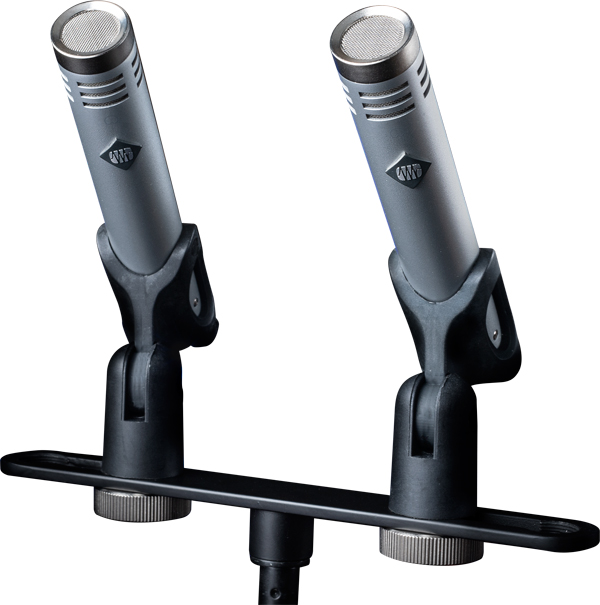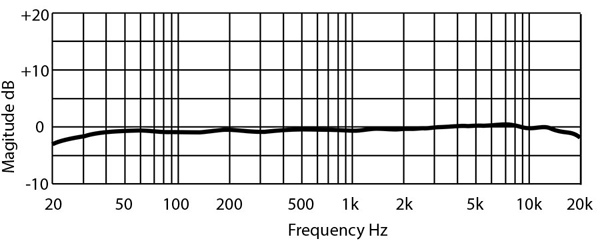
Barry's Mix Magazine Equipment And Software Reviews
Barry's Massive Discography And Engineering Career
Barry's Music Connection Magazine Reviews
Barry's Resolution Magazine Reviews
PreSonus Audio PM-2 Stereo Microphone Kit
By Barry Rudolph
 | PreSonus Audio PM-2 Stereo Microphone Kit |
 | PreSonus Audio PM-2 Frequency Plot |
The PreSonus PM-2 stereo set of matched small-diaphragm cardioid condenser microphones is the newest addition to the growing line of inexpensive microphones offered by the company. Curated and precisely specified by PreSonus in Baton Rouge, La., this line of Asian-manufactured microphones also includes both the PX-1 large-diaphragm condenser and the PRM1 Precision Reference measurement microphones.
The PM-2 comes as a stereo kit with two closely matched pencil microphones that each measure 13.5 cm (5.3 inches) long. In the kit are two flexible mic clips and an adjustable stereo mounting bar. The stereo bar is slotted so that the mic clips can slide into any position between 9.5 cm (3.74 inches) to 17 cm (6.7 inches) apart. To lock into a position, the bar uses two captive thumbscrews that easily screw into the bottom of the mic clips. Overall, I thought the build-quality of these featherweight microphones was excellent compared to other condenser microphones I've seen in this price range.
The microphones use center-terminated, 19 mm (0.75 inches) diaphragms in capsules that screw on the end of the mic's body. (Currently, PreSonus has no plans to offer omni capsules.) The capsules have 6-micron thick gold-sputtered Mylar diaphragms and a Class-A FET head amplifier that draws 5.38mA of 48-volt phantom power. The mic's sensitivity is rated at 8mV/Pa, with a frequency response of 40 Hz to 18 kHz; the A-weighted equivalent noise is 22dB SPL with maximum SPL specified at 135 dB.
Small-diaphragm condenser (SDC) mics like the PM-2 have diaphragms with very low masses that respond quickly and accurately to transients and high frequencies. They make for fine microphones, especially suited for recording delicate acoustic guitars, orchestral instruments, and certainly drums and percussion.
In the Studio
I tried the PM-2 kit using two different stereo microphone techniques especially suited for SDC microphones, and both produced the desired results. First up was a coincident pair in X/Y stereo for recording a Taylor six-string acoustic that my artist uses for songwriting. We were looking for a wider stereo image of the guitar than just a mono recording with a single mic.
I used one PreSonus PM-2 "crossed over" the other one as a coincident X/Y pair with the mics angled 90-degrees and above each other, but not touching. Here I could have used a taller clip and/or a spacer that lifted one mic up to fully clear the other mic. I put the two clips at the max 17 cm distance (6.67 inches) on the bar. The mic bodies stuck out of the clips right up to the XLR connectors--the clip grabs the very end of the mic.
With the microphone capsules so close together, directional information is essentially due to level differences between the two mics. I placed the crossed PM-2 pair over the 12th fret of the Taylor and about six inches out. One PM-2 aimed back at the sound hole and the other PM-2 "looked" up the guitar's fingerboard.
For loud strumming, I used about 36 dB of gain from a Drawmer 1970 Dual FET Compressor Pre-Amplifier with the 70Hz; 12dB/Oct highpass filters switched in, and no EQ or compression. Using the highpass filter was optional--these mics did not hype up the bass frequencies excessively, nor did I have much proximity effect.
Right from the start, the sound of the acoustic was wonderful! I got a full-balanced, warm and rich sound with good low-frequency transients properly represented and a midrange that was clear and transparent. Part of my player's style is to hit the guitar body with his fist as an accent, and instead of getting a big booming noise it was a tight and percussive solid thump.
I did try compressing lightly with the Drawmer 1970's onboard stereo compressor with a ratio of 2:1, medium attack and release times. I stereo-linked the compressor channels because the mic picking up the low frequencies from the sound hole tended toward more gain reduction and I wanted both mic's contribution to the stereo image to track together.
Although X/Y stereo offered good mono compatibility, it provided minimal stereo width. We were looking for a yet wider sound.
DIN, ORTF and DIN Stereo Techniques
For using DIN (Deutsches Institu fŘr Normung) and ORTF (Office de Radiodiffusion TÚlÚvision Franšaise) stereo techniques, the supplied stereo bar is not long enough and the mics are too short to crossover and make the 20 cm (90-degree DIN) or 17 cm (110-degree ORTF) specification for the proper capsule-to-capsule distance.
But NOS (Nederlandse Omroep Stichting) did work well, where the mics are angled at 90 degrees, pointed outward left and right, and measured 30 cm 11.8 inches) apart. This technique produces both difference-in-level and difference-in-time stereo imaging, delivering a much wider stereo sound versus X/Y.
For the guitar tracking session, we achieved the desired stereo width using NOS. If I pulled the PM-2 pair further away from the guitarist, I obtained more room tone and the feeling of an even larger stereo sound stage.
The PreSonus PM-2 makes a great entry-level stereo pair for recording acoustic guitars, solo violins, orchestral instruments, or even overhead on drum kits.
Highly recommended!
|
|
|
|
|
|